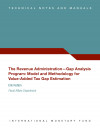The RA-GAP methodology was designed by the IMP to assist revenue administrations from IMF member countries in monitoring taxpayer compliance through tax gap analysis. The tool has been used by developing countries to optimise their tax collection system, in particular for value-added tax (VAT), which can vary consistently from sector to sector.
RA-GAP has some distinct advantages over commonly used methodologies. By using a value-added approach to estimating potential VAT revenues, as compared to the more traditional final consumption approach used by most countries undertaking VAT gap estimation, the RA-GAP methodology can provide VAT compliance gap estimates on a sector-by-sector basis, which assists revenue administrations to better target compliance efforts to close the gap. In addition, the RA-GAP methodology uses a unique measurement for actual VAT revenues, which isolates changes in revenue performance that might be due to cash management (e.g., delays in refunds) from those due to actual changes in taxpayer compliance.
